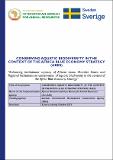Conserving Aquatic Biodiversity in the Context of the Africa Blue Economy Strategy (ABES)

View/
Language
enDate
2021Author
AU-IBAR
Item Usage Stats
124
views
views
37
downloads
downloads
Abstract
The African continent is adjacent to highly productive marine ecosystems including the seven African
Large Marine Ecosystems (LMEs) viz., Agulhas Current LME, Benguela Current LME, Guinea Current LME,
Canary current LME, Mediterranean Sea LME, Red Sea LME and Somali Current LME. The continent is also
endowed with networks of rivers and lakes. The seas, oceans, lakes and rivers inhabit significant number
of biodiversity and the ecosystems provide sources of livelihoods, food security and wealth. These African aquatic ecosystems inhabit living and non-living resources; however the unsustainable exploitation of these resources are threatening the biodiversity, resources and environmental sustainability.
Description
The objective of the Africa Blue Economy Strategy (ABES) is to guide the development of an
inclusive and sustainable blue economy that becomes a significant contributor to continental transformation and growth, through advancing knowledge on marine and aquatic biotechnology, environmental sustainability, marine ecosystem utilization, management and conservation and carbon sequestration, the growth of an Africa-wide shipping industry, the development of sea, river and lake transport, the management of fishing activities on these aquatic spaces, and the exploitation and beneficiation of deep sea mineral and other marine resources.